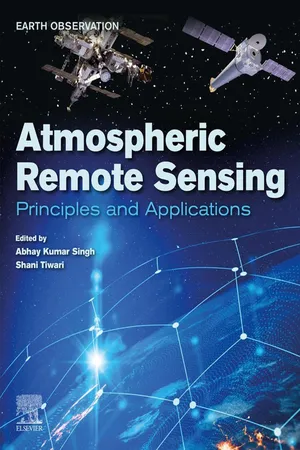
- 480 pages
- English
- ePUB (mobile friendly)
- Available on iOS & Android
eBook - ePub
About this book
Atmospheric Remote Sensing: Principles and Applications discusses the fundamental principles of atmospheric remote sensing and their applications in different research domains. Furthermore, the book covers the basic concepts of satellite remote sensing of the atmosphere, followed by Ionospheric remote sensing tools like Global Positioning System (GPS) and Very Low Frequency (VLF) wave. Sections emphasize the applications of atmospheric remote study in Ionospheric perturbation, fire detection, aerosol characteristics over land, ocean and Himalayan regions. In addition, the application of atmospheric remote sensing in disaster management like dust storms, cyclones, smoke plume, aerosol-cloud interaction, and their impact on climate change are discussed.
This book is a valuable reference for students, researchers and professionals working in atmospheric science, remote sensing, and related disciplines.
- Covers the fundamentals of remote sensing as applied to atmospheric science
- Includes methods and applications of remote sensing technologies for atmospheric science and related disciplines in earth science
- Includes full color photographs and figures that visually represent concepts discussed in the book
Frequently asked questions
Yes, you can cancel anytime from the Subscription tab in your account settings on the Perlego website. Your subscription will stay active until the end of your current billing period. Learn how to cancel your subscription.
At the moment all of our mobile-responsive ePub books are available to download via the app. Most of our PDFs are also available to download and we're working on making the final remaining ones downloadable now. Learn more here.
Perlego offers two plans: Essential and Complete
- Essential is ideal for learners and professionals who enjoy exploring a wide range of subjects. Access the Essential Library with 800,000+ trusted titles and best-sellers across business, personal growth, and the humanities. Includes unlimited reading time and Standard Read Aloud voice.
- Complete: Perfect for advanced learners and researchers needing full, unrestricted access. Unlock 1.4M+ books across hundreds of subjects, including academic and specialized titles. The Complete Plan also includes advanced features like Premium Read Aloud and Research Assistant.
We are an online textbook subscription service, where you can get access to an entire online library for less than the price of a single book per month. With over 1 million books across 1000+ topics, we’ve got you covered! Learn more here.
Look out for the read-aloud symbol on your next book to see if you can listen to it. The read-aloud tool reads text aloud for you, highlighting the text as it is being read. You can pause it, speed it up and slow it down. Learn more here.
Yes! You can use the Perlego app on both iOS or Android devices to read anytime, anywhere — even offline. Perfect for commutes or when you’re on the go.
Please note we cannot support devices running on iOS 13 and Android 7 or earlier. Learn more about using the app.
Please note we cannot support devices running on iOS 13 and Android 7 or earlier. Learn more about using the app.
Yes, you can access Atmospheric Remote Sensing by Abhay Kumar Singh,Shani Tiwari in PDF and/or ePUB format, as well as other popular books in Technology & Engineering & Meteorology & Climatology. We have over one million books available in our catalogue for you to explore.
Information
Table of contents
- Title of Book
- Cover image
- Title page
- Table of Contents
- Front Matter
- Copyright
- Contributors
- Chapter 1 Composition and thermal structure of the earth’s atmosphere
- Chapter 2 Retrieval of aerosol optical depth from satellite observations: Accuracy assessment, limitations, and usage recommendations over South Asia
- Chapter 3 Global Navigation Satellite Systems and their applications in remote sensing of atmosphere
- Chapter 4 Estimation of ionospheric total electron content (TEC) from GNSS observations
- Chapter 5 Remote sensing data extraction and inversion techniques: A review
- Chapter 6 Appraisal of radiative transfer model 6SV for atmospheric correction of multispectral satellite image towards land surface temperature retrieval
- Chapter 7 Spatio-temporal variation of biomass burning fires over Indian region using satellite data
- Chapter 8 Identification of different aerosol types over a semi-arid location in southern peninsular India retrieved from the CALIPSO
- Chapter 9 Remote Sensing of Cloudiness: Challenges and Way Forward
- Chapter 10 Overview of aerosol–cloud interactions over Indian summer monsoon region using remote sensing observations
- Chapter 11 Aerosol loading over the Northern Indian Ocean using space-borne measurements
- Chapter 12 Balloon-Based Remote Sensing of the Atmosphere
- Chapter 13 Vertical distribution of atmospheric brown clouds using Lidar remote sensing over Indian region
- Chapter 14 Application of remote sensing to study forest fires
- Chapter 15 Study of the atmospheric and ionospheric phenomenon using GPS-based remote sensing technique
- Chapter 16 Low-latitude upper atmosphere remote sensing using very low frequency (VLF) waves
- Chapter 17 Remote Sensing of Ionospheric Irregularities
- Chapter 18 Characteristics of tropical cyclones through remote sensing-based observational platforms
- Chapter 19 Significance of remote sensing in tropical cyclone prediction and disaster management: Indian perspective
- Chapter 20 Dust storm characteristics over Indo-Gangetic basin through satellite remote sensing
- Chapter 21 Remote sensing-based geomorphological mapping of glacial and paraglacial landforms from semiarid and subhumid Himalaya
- Chapter 22 Machine learning in remote sensing data—a classification case study
- Chapter 23 Remote sensing-based study of landslide hazard zonation in Namchi and its surrounding area of Sikkim, India
- Index